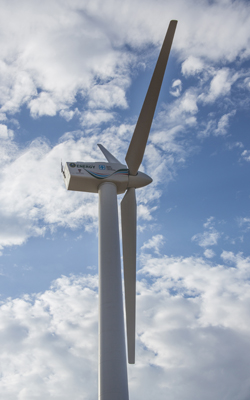
One of several rebuilt turbines works on the SWiFT facility in Texas. SWiFT is the first public facility of its kind to use multiple wind turbines to measure how wind turbines interact with one another in a wind farm.
The U.S. Department of Energy (DOE), Sandia National Laboratories and Texas Tech University recently commissioned the DOE/Sandia Scaled Wind Farm Technology (SWiFT) facility at the Reese Technology Center in Lubbock, Texas. The SWiFT is the first public facility of its kind to use multiple wind turbines to measure how wind turbines interact with one another in a wind farm.
The event featured speakers from the DOE’s Wind Program, Vestas Wind Systems, Sandia and Texas Tech.
“The Energy Department’s wind testing facilities, including the Scaled Wind Farm Technology site in Texas, support the continued growth of our nation’s clean energy economy while helping speed deployment of next generation energy technologies and bring more clean, affordable, and renewable power to American homes and businesses,” said Assistant Secretary for Energy Efficiency and Renewable Energy David Danielson.
Jon White of Sandia’s Wind Energy Technologies Department, technical lead for the project, said SWiFT is the first moderate-scale facility — allowing up to 10 wind turbines —to investigate, test, and develop technology for wind plants. “Some estimates show that 10 to 40% of wind energy production and revenue is lost due to complex wind plant interaction,” said White.
White says the SWiFT facility allows for rapid, cost-efficient testing and development of transformative wind energy technology, with specific emphasis on improving wind plant performance. The facility’s advanced testing and monitoring will help researchers evaluate how larger wind farms can become more productive.
SWiFT will host open-source and proprietary research as the result of a partnership among Sandia, Vestas, Texas Tech’s National Wind Institute at Reese Technology Center and Group NIRE, a renewable energy development company.
White says the three year process to develop the facility has been rewarding and challenging. “It has been a phenomenal experience to work with a diverse team to complete the often under-appreciated process of turbine construction. We also had a 1980s-era, smaller turbine rebuilt to perform like a much larger machine,” White said.
“The project was a complete green-field construction so there was tremendous complexity in scheduling and managing all of the agreements and contracts to access to the facility, verify there wouldn’t be an adverse environmental impact, procure the equipment, and contract numerous specialized labor resources. We succeeded primarily because we have a dedicated and competent team and a steadfast DOE customer,” says White.
Researchers have begun planning the site’s first research projects. Two primary research projects for the next year will be testing and evaluating Sandia’s new National Rotor Testbed Project and collecting baseline data for turbine-turbine interaction that can be used by the international community to improve wind plant performance.
The National Rotor Testbed Project will provide a public, open-source complete rotor design that the wind energy community can work on collaboratively to bring the best technology to market as rapidly and cost-efficiently as possible, says White.
Funding for the work comes from the DOE’s Office of Energy Efficiency and Renewable Energy.
For more information on SWiFT, see previous news releases or visit the SWIFT website.
Sandia National Laboratory
www.sandia.gov
Filed Under: Construction, News, Projects




